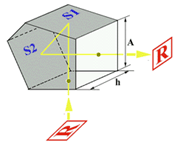|
Penta Prism is a five-sided prism containing two reflecting surfaces at 45° to each other, and two refracting faces perpendicular to the entering and emerging beams. The important properties of Penta Prism are:
|
 |
|
Only two of the inclined sides are used to reflect light; manufacturers create the fifth side, or face, by removing a corner to reduce the weight and size of the prism. Engineers specify a penta prism rather than a double mirror because of several advantages found in the prism’s construction. One of those advantages is stability. Glass has a low coefficient of expansion, and alignment of the reflecting surfaces of the prism will remain constant over a long time even when exposed to environmental changes and shocks. |
  |
|
A second advantage is in simplicity and ease of assembly. A penta prism can be placed into a single mount, whereas two mirrors would require two separate mountings and a more complex procedure for assembly. Still another advantage to the prism lies in its size. A penta prism can be easily manufactured with small dimensions and then simply placed into an assembly. A miniature mirror system might require special design for mountings and special tools for assembly. The geometry of reflection inherent in a penta prism deserves special note. The 90° deviation, which is imparted to the incoming beam, remains constant for different angles of incidence. This invariance means that alignment of a penta prism is not critical in terms of the deviation of a centerline through 90°. Although this invariance to alignment is shared by other prisms oriented for two coplanar reflections, the penta prism is unique in its ability to deviate the centerline by precisely 90°. The manufacturing tolerance of the 45° angle between the two reflecting faces determines the accuracy of the centerline’s 90° deviation. |
|
Penta Prisms
